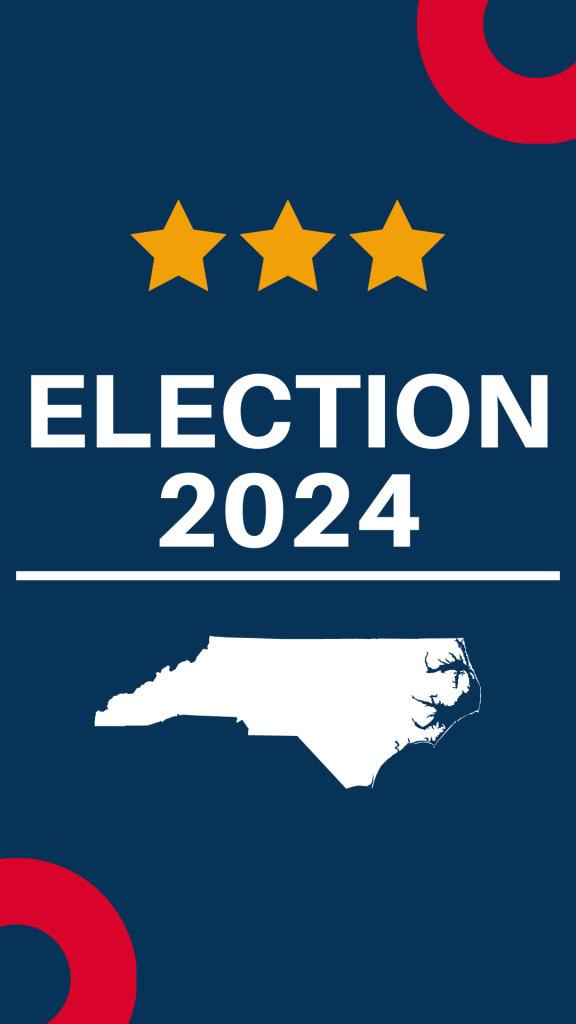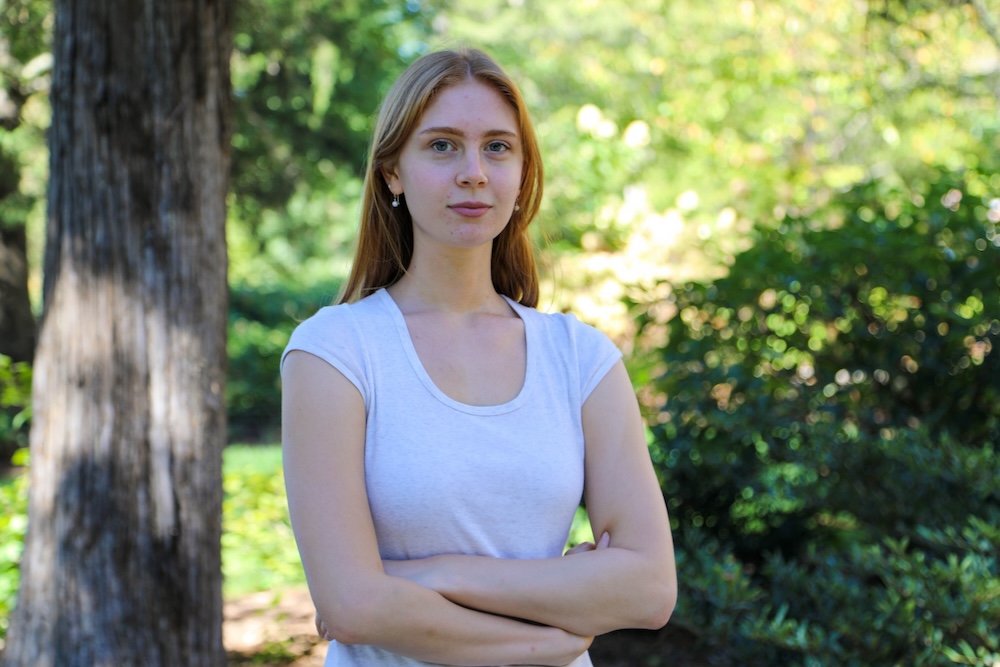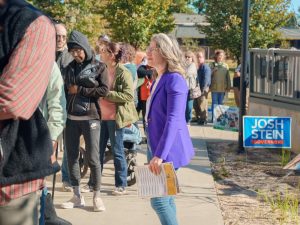Duke University senior Catherine Flanagan arrived at the March 2024 polls excited and prepared, with her driver’s license and list of preferred candidates in hand.
“I thought, ‘This will be a breeze. I’ll just fly straight through,’” said Flanagan.

But she barely made it inside before discovering that her New York driver’s license would not be accepted due to a technicality: under North Carolina’s new voter ID laws, out-of-state IDs are only valid if a voter registers within 90 days of the election.
Flanagan was handed a provisional ballot, a temporary ballot issued when a voter’s eligibility is in question. To ensure her vote counted, she would need to come back later, bringing her passport to the county Board of Elections office.
But she couldn’t make it. “I didn’t have a car on campus, and so I was lucky to have even made it to the polls,” she said.
Her provisional ballot was thrown away, along with those of hundreds of other students, according to State Board of Elections data.
“I felt guilty and a little silly for having taken the time to do all of that,” said Flanagan.
Youth votes can sway election outcomes. In 2008, the last time North Carolina voted blue in a presidential election, youth voters helped flip the state. Barack Obama won the state by less than one percent, and exit polls revealed that he lost every age group except 18- to 29-year-olds.
The stakes are high as Election Day approaches, with Harris and Trump running neck and neck in North Carolina. Yet, since the 2008 election, young people in North Carolina have been issued provisional ballots at disproportionate rates, a trend that has complicated the voting process and left many students confused. Between 2008 and 2020, youth voters in North Carolina were 14 times more likely to cast provisional ballots than were voters older than 65.
And in North Carolina in 2020, over 10,000 voters aged 18-25 cast provisional ballots. Some 80 percent — nearly 8,000 ballots — were thrown out.
“Elections are decided on the basis of these provisional ballots,” said Gunther Peck, an associate professor of history at Duke University.

Youth votes at risk
A provisional ballot is intended to be a safeguard, helping guarantee every citizen’s right to cast their vote. In North Carolina, provisional ballots are most commonly issued if a voter’s registration cannot be found, the address on their registration is incorrect, they show up at the wrong precinct, or they do not have an acceptable ID.
Sometimes, voters are issued provisional ballots for no fault of their own — election workers can make clerical errors such as misspelling a voter’s name while registering them, said Peck.
Once a provisional ballot is cast, the county Board of Elections staff researches voter eligibility and determines whether the vote will count. If problems arise with a ballot, a voter can also take additional steps to ensure that their vote counts. Poll workers are supposed to inform voters of those additional steps.
Election results are not finalized until provisional ballots are counted.
Yet provisional ballots can give students and other voters the false impression that they’ve cast a vote, Peck said. Some students realize only after the fact that their ballot was discarded — if they learn it at all.
In the March primary race, 1 in 8 Duke University student ballots were tossed, a throw-away rate nearly twice that of the Durham County average. Rejection rates were even higher at nearby N.C. Central University.
Provisional ballots can be issued to any voter. But students are particularly vulnerable because they move addresses annually and are often unsure how to update their voter registrations.
“The things that are a normal part of the undergraduate experience — moving, changing dorms every year — create risk,” Peck said.
Students can sort out those problems during the early voting period, between Oct. 17 and Nov. 2.
But students who show up on Nov. 5 without valid registration will be issued a provisional ballot.
The new North Carolina voter ID law has also created confusion because students are unsure what IDs to bring to the polls. Valid passports, North Carolina drivers licenses, and pre-approved physical student ID cards will be accepted. Students can also use driver’s licenses and other government-issued IDs from other states — but only if they register within 90 days of the election. Digital student ID cards will not be accepted.
Avoiding a provisional ballot
Derek Bowens, elections director for Durham County, says provisional ballots should be a last resort.
“We don’t want anybody to vote a provisional ballot,” Bowens said. “And there’s a lot of remedies for folks not to have to vote provisional.”
Those remedies include registering to vote and showing up to early voting, he said.
Voters who did not register before the Oct. 11 deadline can use same-day registration during early voting. However, they should bring some proof of North Carolina residence to the polls. For students, that might be a campus housing agreement or lease agreement.
And voters who do not show up during early voting can also take steps to avoid being issued a provisional ballot on Election Day. They can look themselves up on the state lookup tool to ensure they are registered, use the polling places search tool to see what voting site they should go to based on their home address, and bring a proper ID according to N.C. ‘s ID guidelines.
Still, Bowens urges students to vote early. Provisional ballots are more rare during the early voting period, he said, because students can update any issues with their registration with time to spare.
If students and other voters are offered a provisional ballot during early voting, they can also decline the ballot, fix their registration issue, and return to cast a regular ballot, said Kate Fellman, executive director of You Can Vote, a nonprofit organization that educates and registers N.C. voters.
“We’re so lucky to have that 17 days of early voting,” Fellman said.
“If you show up to early voting and there’s an issue, you don’t have to cast a ballot,” she said. “If you forgot it [your ID], go back, get it and then try again.”
If voters are redirected to the help desk and handed a ballot marked “provisional,” they should ask questions, Fellman added.
“Voting is not a test,” she said. “Ask, ‘Why is this the ballot I’m being offered? Is there any other way I could get a regular ballot?’”
If voters are confused or unsatisfied with the response they receive, they can call Democracy North Carolina’s nonpartisan voter hotline (888) OUR-VOTE Monday-Friday from 9 a.m. to 5 p.m.
If you must cast a provisional ballot, you should
“If you try everything and get stuck still with a provisional ballot,” said Peck, “you should still cast it.”
Voters who cast provisional ballots should receive a set of instructions, including information on checking the status of their ballot, said Bowens. Sometimes, as in the case of an invalid ID, voters can bring materials to the county Board of Elections office within 10 days of the election to resolve problems with their provisional ballot.
Students and others who receive a provisional ballot should also receive an identification number for the ballot, which they can use to track its status online. Voters with questions about how to cure their provisional ballots can call the Durham County Board of Elections at (919) 560-0700.
“We wil assist you,” said Bowens. “We want to make sure that you have the opportunity to vote, and vote a traditional ballot.”
Peck hopes students and other young voters will take necessary steps to ensure their votes count.
“It’s the first time voting for many students.” he said. “So it’s not just one vote in one election. It’s a lifetime of engagement with this thing we call democracy.”
Above: Duke University senior Catherine Flanagan thought she had voted in the March primary, but her provisional ballot was ultimately rejected. Photo by Abigail Bromberger — The 9th Street Journal






